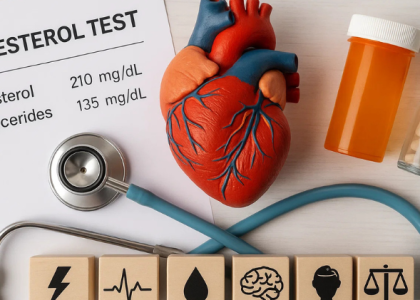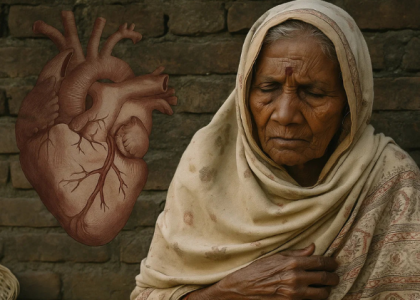“My sugar is a little high, but I feel fine.” That’s what many South Asians say—until they have a heart problem.
When Raj, a 48-year-old software engineer from Mumbai living in America, went for his annual check-up, his doctor told him his blood sugar was in the prediabetes range. Raj wasn’t worried. He wasn’t overweight, had no symptoms, and still played cricket on weekends.
Three years later, he ended up in the emergency room with chest pain. The diagnosis? A heart attack caused by
damaged blood vessels—damage that had been silently building because of his untreated high blood sugar.
Unfortunately, stories like Raj’s are becoming more common in our South Asian communities. Let’s understand why and what we can do about it.
What’s the Link Between Diabetes and Heart Disease?
Think of your blood vessels as pipes that carry blood to your heart and throughout your body. High blood sugar (diabetes) is like having slightly acidic water flowing through these pipes year after year.
Here’s what happens when diabetes affects your heart:
- Silent inflammation: High blood sugar causes ongoing, low-level inflammation in your blood vessels. You can’t feel it happening, but it’s like a slow-burning fire damaging your heart.
- Weakened heart muscle: Over time, diabetes can weaken your heart’s pumping ability. This means your heart works harder to do its job.
- Blocked arteries: Diabetes speeds up the process of fatty deposits building up in your arteries (atherosclerosis), making it harder for blood to flow to your heart.
- Damaged nerves: Diabetes can harm the nerves that control your heart rate and blood pressure, making heart problems harder to detect.
Simply put: Diabetes makes your heart age faster, even if you feel okay. According to the American Heart Association, adults with diabetes are 2-4 times more likely to die from heart disease than those without diabetes.
Why This Is Worse for South Asians
According to research from the World Health Organization, South Asians face special challenges when it comes to diabetes and heart health:
- We get diabetes at younger ages – often 5-10 years earlier than other ethnic groups
- We have a different body type – many of us are thin outside but have hidden belly fat inside that increases insulin resistance
- Our traditional foods can raise blood sugar quickly – white rice, sweets, fried snacks, and even fruit juices cause rapid sugar spikes
- We tend to be less physically active – especially after middle age
- Many of us dismiss early warning signs – “a little sugar” doesn’t sound serious, so we delay treatment
- We develop heart disease earlier – about 10 years earlier than other populations
The American Diabetes Association notes that nearly 1 in 5 South Asians has either diabetes or prediabetes, often without knowing it.
Warning Signs to Watch For
Watch for these warning signs that diabetes might be affecting your heart:
Heart-related signs:
- Chest discomfort, pressure, or pain, especially during activity
- Shortness of breath when doing things that used to be easy
- Unusual tiredness or fatigue
- Swelling in the feet, ankles, or legs
- Irregular heartbeat or palpitations
Diabetes warning signs:
- Feeling very thirsty often
- Urinating more frequently, especially at night
- Blurry vision that comes and goes
- Cuts or sores that heal slowly
- Tingling or numbness in hands or feet
Remember: Many people have NO obvious symptoms in the early stages of both diabetes and heart disease. That’s why they’re called “silent killers.”
What You Can Do Today
The good news? You can take control of your health with some simple steps. Research published in the journal Circulation shows that lifestyle changes can reduce heart disease risk by up to 80%, even in people with diabetes.
Here are actions you can start today:
Get tested regularly:
- Fasting blood sugar test
- HbA1c (shows average blood sugar over 3 months)
- Complete cholesterol panel (HDL, LDL, triglycerides)
- Blood pressure check
- Waist measurement (men should be less than 90 cm or 35.5 inches; women less than 80 cm or 31.5 inches)
Make simple food swaps:
- Replace white rice with brown rice, millet, or barley at least 2-3 times a week
- Start meals with vegetables or salad before the carbohydrates
- Choose whole fruits instead of fruit juice
- Reduce fried snacks to once a week treats
Move more:
- Walk for 10 minutes after meals to lower blood sugar naturally
- Aim for 30 minutes of walking daily (can be broken into three 10-minute sessions)
- Add strength exercises twice a week (even lifting water bottles counts!)
- Break up sitting time – stand up every 30 minutes
Work with your doctor:
- Ask: “How is my heart handling my sugar levels?”
- Discuss whether you need medication or if lifestyle changes are enough
- Follow up regularly, not just when something feels wrong
- Bring a family member to appointments if that helps you understand better
A Message for Families
Diabetes and heart disease often run in families. If you have these conditions, your blood relatives (parents, siblings, children) have a higher risk too.
Here’s how families can support each other:
- Talk openly about health conditions in your family
- Cook and exercise together to make healthy changes easier
- Remind each other about doctor appointments and medications
- Create a family WhatsApp group to share healthy recipes or walking achievements
- Celebrate progress together, no matter how small
Remember that caring for your heart is not just for yourself, but for those who love and need you. As we say in our communities, health is wealth—the greatest gift you can give your family is taking care of yourself.
Small Steps, Big Results
You don’t need to change everything overnight. Even small improvements can make a big difference over time.
As the Indian Heart Association reminds us, South Asians can dramatically reduce their heart disease risk by managing diabetes early and effectively. Every small step you take today is an investment in many more healthy years with your loved ones.
Don’t wait until you feel sick. The best time to protect your heart is now.




